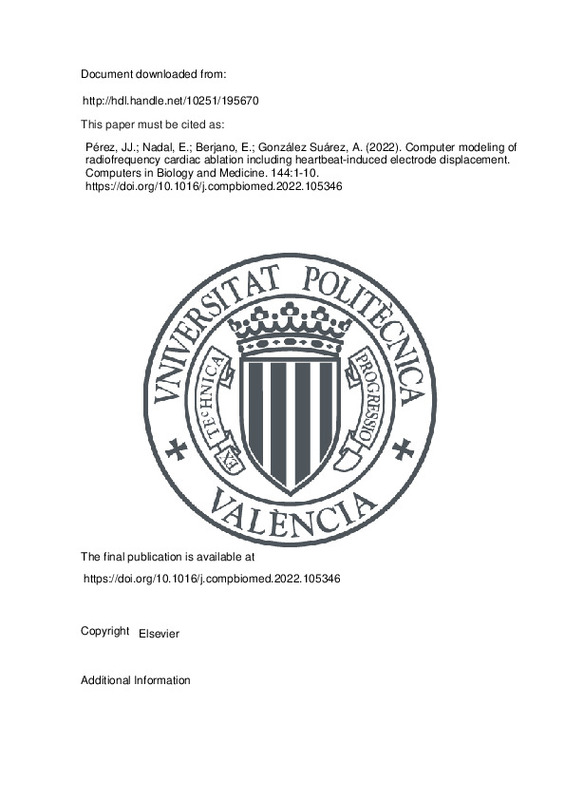JavaScript is disabled for your browser. Some features of this site may not work without it.
Buscar en RiuNet
Listar
Mi cuenta
Estadísticas
Ayuda RiuNet
Admin. UPV
Computer modeling of radiofrequency cardiac ablation including heartbeat-induced electrode displacement
Mostrar el registro sencillo del ítem
Ficheros en el ítem
| dc.contributor.author | Pérez, Juan J
|
es_ES |
| dc.contributor.author | Nadal, Enrique
|
es_ES |
| dc.contributor.author | Berjano, Enrique
|
es_ES |
| dc.contributor.author | González Suárez, Ana
|
es_ES |
| dc.date.accessioned | 2023-07-27T18:02:05Z | |
| dc.date.available | 2023-07-27T18:02:05Z | |
| dc.date.issued | 2022-05 | es_ES |
| dc.identifier.issn | 0010-4825 | es_ES |
| dc.identifier.uri | http://hdl.handle.net/10251/195670 | |
| dc.description.abstract | [EN] Background: The state of the art in computer modeling of radiofrequency catheter ablation (RFCA) only considers a static situation, i.e. it ignores ablation electrode displacements induced by tissue movement due to heartbeats. This feature is theoretically required, since heartbeat-induced changes in contact force can be detected during this clinical procedure. Methods: We built a 2D RFCA model coupling electrical, thermal and mechanical problems and simulated a standard energy setting (25 W-30 s). The mechanical interaction between the ablation electrode and tissue was dynamically modeled to reproduce heartbeat-induced changes in the electrode insertion depth from 0.86 to 2.05 mm, which corresponded with contact forces between 10 and 30 g when cardiac tissue was modeled by a hyperelastic Neo-Hookean model with a Young's modulus of 75 kPa and Poisson's ratio of 0.49. Results: The lesion size computed in the dynamic case was 6.04 mm deep, 9.48 mm maximum width and 6.98 mm surface width, which is within the range of previous experimental results based on a beating heart for a similar energy setting and contact force. The lesion size was practically identical (less than 0.04 mm difference) in the static case with the electrode inserted to an average depth of 1.46 mm (equivalent to 20 g contact force). Conclusions: The RFCA model including heartbeat-induced electrode displacement predicts lesion depth reasonably well compared to previous experimental results based on a beating heart model. | es_ES |
| dc.description.sponsorship | Grant RTI2018-094357-B-C21 funded by MCIN/AEI/10.13039/501100011033 (Spanish Ministerio de Ciencia, Innovacion y Universidades/Agencia Estatal de Investigacion). | es_ES |
| dc.language | Inglés | es_ES |
| dc.publisher | Elsevier | es_ES |
| dc.relation.ispartof | Computers in Biology and Medicine | es_ES |
| dc.rights | Reconocimiento - No comercial - Sin obra derivada (by-nc-nd) | es_ES |
| dc.subject | Computer model | es_ES |
| dc.subject | Contact force | es_ES |
| dc.subject | Mechanical deformation | es_ES |
| dc.subject | Radiofrequency ablation | es_ES |
| dc.subject.classification | TECNOLOGIA ELECTRONICA | es_ES |
| dc.subject.classification | INGENIERIA MECANICA | es_ES |
| dc.title | Computer modeling of radiofrequency cardiac ablation including heartbeat-induced electrode displacement | es_ES |
| dc.type | Artículo | es_ES |
| dc.identifier.doi | 10.1016/j.compbiomed.2022.105346 | es_ES |
| dc.relation.projectID | info:eu-repo/grantAgreement/AEI/Plan Estatal de Investigación Científica y Técnica y de Innovación 2017-2020/RTI2018-094357-B-C21/ES/MODELADO Y EXPERIMENTACION PARA TERAPIAS ABLATIVAS INNOVADORAS/ | es_ES |
| dc.rights.accessRights | Abierto | es_ES |
| dc.contributor.affiliation | Universitat Politècnica de València. Escuela Técnica Superior de Ingenieros Industriales - Escola Tècnica Superior d'Enginyers Industrials | es_ES |
| dc.contributor.affiliation | Universitat Politècnica de València. Escuela Técnica Superior de Ingeniería del Diseño - Escola Tècnica Superior d'Enginyeria del Disseny | es_ES |
| dc.description.bibliographicCitation | Pérez, JJ.; Nadal, E.; Berjano, E.; González Suárez, A. (2022). Computer modeling of radiofrequency cardiac ablation including heartbeat-induced electrode displacement. Computers in Biology and Medicine. 144:1-10. https://doi.org/10.1016/j.compbiomed.2022.105346 | es_ES |
| dc.description.accrualMethod | S | es_ES |
| dc.relation.publisherversion | https://doi.org/10.1016/j.compbiomed.2022.105346 | es_ES |
| dc.description.upvformatpinicio | 1 | es_ES |
| dc.description.upvformatpfin | 10 | es_ES |
| dc.type.version | info:eu-repo/semantics/publishedVersion | es_ES |
| dc.description.volume | 144 | es_ES |
| dc.identifier.pmid | 35240375 | es_ES |
| dc.relation.pasarela | S\456109 | es_ES |
| dc.contributor.funder | AGENCIA ESTATAL DE INVESTIGACION | es_ES |







![[Cerrado]](/themes/UPV/images/candado.png)

